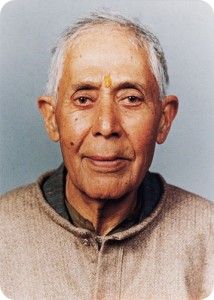 Consciousness is the most intimate experience of life, the essence of life itself. Among the many spiritual traditions born and developed in India, one ancient philosophy—Kashmir Shaivism—has explored it completely. Kashmir Shaivism explains that reality is understood to be just One and that reality is Shiva. He is the pure conscious nature that manifests as all things. Like a light that shines and illumines everything, the light of consciousness shines, illuminating its own infinite manifestations. This shining of Shiva is eternal, unending, undivided, and in all ways unconditioned. What we live and experience in our daily lives, in every moment, is part of that immense consciousness. He shines, manifests, and is everything and everybody – all that happens in our lives, as well as the means by which we perceive it all.
Consciousness is the most intimate experience of life, the essence of life itself. Among the many spiritual traditions born and developed in India, one ancient philosophy—Kashmir Shaivism—has explored it completely. Kashmir Shaivism explains that reality is understood to be just One and that reality is Shiva. He is the pure conscious nature that manifests as all things. Like a light that shines and illumines everything, the light of consciousness shines, illuminating its own infinite manifestations. This shining of Shiva is eternal, unending, undivided, and in all ways unconditioned. What we live and experience in our daily lives, in every moment, is part of that immense consciousness. He shines, manifests, and is everything and everybody – all that happens in our lives, as well as the means by which we perceive it all.
If you ask a fish what water is, the fish will reply “what water?” In the same way, man recognizes least that which is the greatest constant in his life—the experience of being Conscious.
– Mike Yap
The essence of the entire teaching is that anything we do for our spiritual development is ultimately to achieve the recognition that there is only that one reality and it is who we are: we are that Shiva who is shining and manifesting as all things. I have always felt that what the Tantrics were teaching was very much in consonance with what one would aspire to experience in one’s own life. And the way it was all expressed was also wonderfully beautiful.
https://www.youtube.com/watch?v=LY243YMOfYo
Kashmir Shaivism’s View of God
In Kashmir Shaivism, God is understood to be Shiva Awareness (male) and Shakti Power (female). The two are actually not separate (duality)—they are the one in the same (non-duality). Their love is known as the Tantric marriage which describes the union of lover (Shakti) and beloved (Shiva).
If you get God, you get Goddess. Can’t have one without the (M)other.
– Jeff Brown
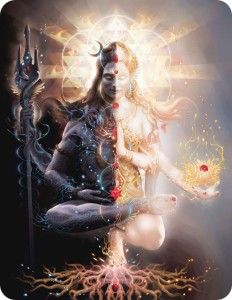 It is said that Consciousness, Shiva, out of his pure freedom (svatantrya), chooses to create bondage. He chooses to forget his true nature, out of his desire to be all things, thus he manifests that which is impossible—creating a world of dualities (his Shakti) without ever losing his oneness. To ask why Shiva would create the universe and undergo contraction and suffering is a serious question. There are many possible answers. You could say that given infinite time and space, infinite Consciousness would willingly explore every possibility.
It is said that Consciousness, Shiva, out of his pure freedom (svatantrya), chooses to create bondage. He chooses to forget his true nature, out of his desire to be all things, thus he manifests that which is impossible—creating a world of dualities (his Shakti) without ever losing his oneness. To ask why Shiva would create the universe and undergo contraction and suffering is a serious question. There are many possible answers. You could say that given infinite time and space, infinite Consciousness would willingly explore every possibility.
The Dream Theory
Imagine you live in a dimension where you have total control. Nothing happens without your permission, and everything you want to happen happens. For a while, you’d probably enjoy innumerable pleasures and luxuries. Then, after not so very long, you’d get bored, and you’d invent adventures for yourself to go on that seemed to include challenge, such as rescuing a damsel from a fire-breathing dragon. But even that would pale eventually because you’re always in control. The challenge isn’t real, because there is no possibility of failing. Sooner or later, you fall into boredom. Then one day a magical machine appears with a big button, and next to the button a sign. The sign says:
If you push this button, anything could happen. Joys beyond your wildest dreams, and fears beyond your darkest nightmares; or more probably, both. If you push it you will forget you pushed it and be plunged into a world of infinite possibility. Will you take the chance? Will you go on the adventure?
The question is not whether you’ll push the button. It’s just how long will you wait?
The story shows that as much as we think we would be happy bending the world entirely to our individual will, we would not. It is only by giving full range to all the possibilities within consciousness that we will be satisfied with our true infinite nature.
What better way to feel freedom, than to be bound and limited.
– Leanne Kitteridge
The Divine Separation
Once Shiva and Shakti separate, the divine pair, yamala, like the yin-yang, incorporate all the dualities within them. Two spirits separate for the sheer joy of coming back together, which continues in an endless cycle, known as the divine play, a universal game of hide and seek; concealment (nimesa) and revilement (unmesa). Shiva loves to re-discover his true Nature, again and again.
I offer salutations to the God and the Goddess: the infinite parents of the world.
The lover, out of boundless love, has become the Beloved.
Because of Her, He exists,
And without Him, She would not be.
– Jnaneshwar Maharaj
The more deeply we grow in our individual spirituality, the more genuine is our experience of unity. To remove the feeling of duality, we must first establish our separateness. Healthy separation creates what we call a feeling of “two-ness”, which is just as important as “oneness”. You must understand that the feeling of oneness can only happen if we are first in the feeling of two-ness. Coming together is only possible if we are first apart.
I have purposely thrown myself from infinite bliss into finite experience, just so that I can find myself again.
– Mike Yap
Like a gem, hidden by its own brilliance, Consciousness is hidden by all the mental and emotional manifestations that are its own creations.
The most beautiful of rubies is veiled by the brilliance of its own rays.
– Maheshwaranda
The whole play is happening within Shiva’s consciousness. When Shiva opens His eyes, the universe is created. When He closes His eyes it disappears. You will never have a universe beyond your own awareness. Thus, you are the aware subject of the universe you experience. You are Shiva. He begins in ecstasy and freedom, undergoes limitation and suffering out of His own free will, and then yearns for and achieves the recognition and attainment of His true nature. He takes the form of the Guru and teaches Himself in the form of the seeker the path to Consciousness. The goal of our sadhana, once recognizing this divine play, is to gain spiritual liberation through worldly experience. The universe evolves back into consciousness through its various experiences.
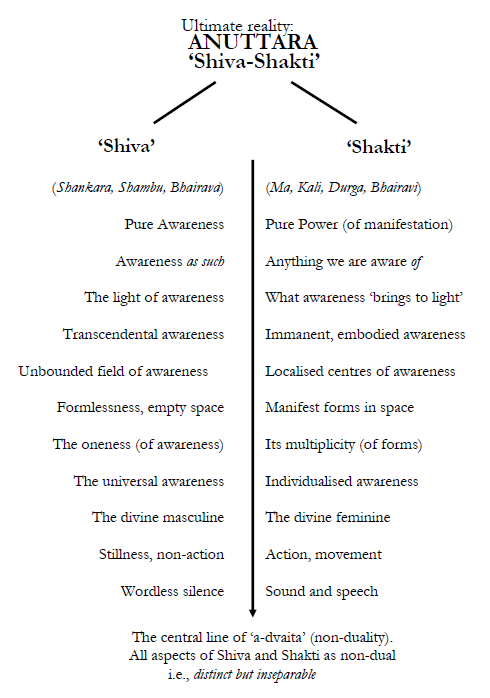
What is the Goal of this Tradition?
There is nothing to do other than to realize your own true essential nature, which is Shiva consciousness. Once realized, the main insight is that the subject, or Consciousness, is not separate from the object, or matter. The liberated being should experience directly that the object he perceives is contained within his subjectivity, that is, within Consciousness (see Theory of Reflection).
Whatever is happening right now is as God as it gets.
– Christopher “Hareesh” Wallis
A liberated being sees the universal (macrocosm) in the specific (microcosm). If everything is made of the same Consciousness then every part recapitulates the whole. As above, so below; whatever is true of God is also true of us. If we want to understand God or the universe then we would do well to understand ourselves. A human being is a hologram of the universe. The ocean is contained in the drop. This mystery transcending time and space is the essence of Consciousness.
Trika Philosophy
Kashmir Shaivism is also called the Trika philosophy, the three-fold science based on the three energies of Shiva, because it discusses these three subjects:
- The nature of the Absolute (Para – Subjective Supreme Energy)
- The nature of the human being and contraction (Apara – Objective Inferior Energy)
- The method by which contraction is overcome, or sadhana (Parapara – Cognitive Intermediate Energy)
Limited in his nature, infinite in his desire, man is a fallen god who remembers heaven.
– Alphonse de Lamartine
As long as one resides in the contracted objective energy one is the victim of sadness and sorrow and is entangled in the wheel of Samsara (repeated births and deaths). One symptom of contracted awareness, is a complete denial of “higher” reality. This denial is not based on blindness but on the absence of experience. So one has to emerge from objective, contracted energy and enter into the supreme subjective energy, in which one is liberated from all this sadness, and becomes absolute in the attainment of final liberation.
The Five (+1) Powers of God
The Divine exercises its five powers as an expression of its innate freedom (svatantrya-shakti) and total autonomy. These powers pervade all reality, and nothing exists separate from them. They are the fundamental nature of God. Kashmir Shaivism invites us to recognize the powers as our own.
Please note: svatantrya-shakti pervades all five powers and thus is considered to be the sixth power.
The human individual is nothing but God in a contracted form. When the individual looks at himself, he notices that he has the same qualities as the Absolute, though they are shrunken and contracted. God has perfect will, perfect knowledge and perfect ability to do, while the human individual has all of these powers in limitation. They show up in him as three basic knots within his being. The first knot is limitation of will. The human individual experiences it in his heart as a painful sense of separation, weakness and grief. This is the fundamental birth trauma in which God becomes the individual. The limitation of knowledge is experienced in the mind. The human mind experiences darkness and confusion and strains to understand the truth. The third knot is experienced in the navel area and is felt as a sense of frustration and lack of fulfilment.
1. Power of Consciousness
Chit-Shakti
- The power of being eternally and absolutely conscious and present. At the cosmic level, this power is pure unconditioned presence, aware of itself and the universe that unfold within it. At the individual level, we experience it as the awareness that allows us to experience both ourselves and the world around us. It is the fundamental experience of being sentient and is shared by all creatures.
2. Power of Bliss
Ananda-Shakti
- The bliss that arises when Supreme Consciousness experiences its own true nature. At the individual level, it can be experienced as every kind of natural happiness: the simple feeling of relaxation or contentment, the satisfaction of eating a delicious meal, the ecstasy of orgasm, the subtle joy of falling in love, or the deep meditative blissfulness.
3. Power of Will
Iccha-Shakti
- The creative impulse of Supreme Consciousness to want to be all things. At the individual level, it is the fundamental will to live, to exist, as well as every form of desire. Our will, or desire, is the source of all creativity.
4. Power of Knowing
Jnana-Shakti
- The power of intuitive knowing and self-organization. It’s the Supreme Intelligence that runs the universe, the power of knowing that exists within every cell. At the invididual level, in the human mind, it is the capacity to know, to plan, to discern, and to make judgements.
5. Power of Action
Kriya-Shakti
- The power of Supreme Consciousness to do anything, such as bring universes into form. To do the impossible, which is create duality while maintaining unity. At the individual level, it manifests as the activities we perform as humans.
The Five Acts of God
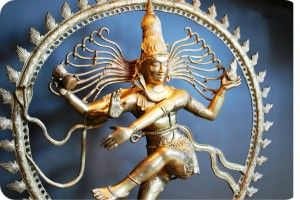
- Shristi – creation, emission, flowing forth of Self-expression
- Sthiti – stasis, maintenance, preservation
- Samhara – dissolution, resorption, retraction
- Tirodhana – concealment, forgetting
- Anugraha – revealing, remembering, grace
The 36 Tattvas (Cosmology)
Kashmir Shaivism is a science that describes the systems by which the universe is manifested (Tattvas). These tattvas are Principles of Reality. The tattva system is a map of the conscious being’s experience of reality.
Agamas (Sacred Scriptures)
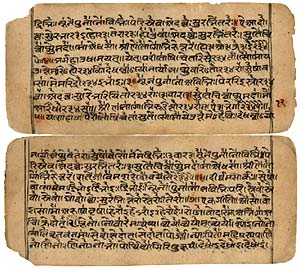
Kashmir Shaivism is based upon Tantras revealed by Shiva, also called Agamas. The word Agamas refers to the sacred teachings that exist within Shiva. And so these scriptures are understood to be Shiva’s revelation.
Every text will have three elements: it will give a philosophical overview, perhaps a depiction of the human condition and human suffering; then it will talk about the spiritual goal, Self-realisation: bliss and wisdom; and finally and most importantly, it will offer a sadhanamanual: specific yogic methods and techniques for attaining the goal.
In Shaivism, there are 92 agamas, as follows:
- the monistic Bhairava Sastras, which are supreme (para), number 64;
- the mono-dualistic Rudra Sastras, which are medium (parapara), number 18;
- and the dualistic and inferior (apara) Siva Sastras number 10.
Kashmir Shaivism derives its teachings from the sixty-four monistic Tantras, known as the Bhairava Tantras, the essence of which is called ‘Trika Shaivism’. Also because the Shiva Sutras were revealed to the sage Vasugupta by Shiva, they are also considered a divine revelation and as such are accepted as agama sastra. In fact, in revealing the absolute monism central to the philosophy of Kashmir Shaivism, the Shiva Sutras are considered to be one of the most important agamas of Trika Shaivism.
The literature of Kashmir Shaivism can be broadly divided into three parts:
Agama Sastra
The Agama Scriptures are revelations from the Supreme God (Shiva) to mankind. These have typically been handed down from teacher to pupil. Some of the works under this heading are: Malinivijaya, Svacchanda, Vijnanabhairava, Mrgendra, Rudrayamala, and the Shiva Sutras.
Spanda Sastra
The Spanda Scriptures are important doctrines of the system. The main works under this heading are: Spanda Sutras or the Spanda Karikas, which elaborate the principles of the Shiva-Sutras. The following commentaries exist on these: Vivrti by Ramakantha, Pradipika by Utpala Vaisnava, Spandasandoha by Ksemaraja, and Spandanirnaya by Ksemaraja.
Pratyabhijna Sastra
The Pratyabhijna Scriptures contain arguments and counter-arguments, discussions, and reasonings. It provides a logical interpretations of the main doctorines of the system.
Schools of Kashmir Shaivism
Many centuries later this Tantric philosophy of Kashmir Shaivism was taught by four great Masters in four great Schools of practice and philosophy. These four Schools are not separate from each other. All four schools can carry you to Universal God-consciousness. Of these, the Kula and the Krama are actually older Tantric schools, dating to perhaps the fourth century. The two others came into being as a direct result of the new insights provided by the Shiva Sutras.
Pratyabhijna School
The first School of Kashmir Shaivism is called Pratyabhijna, which means recognition. The recognition of what one has always been in one’s essential timeless nature (Shiva). It deals with the path of wisdom, and thus includes many philosophical matters and sound reasoning as the means to experience this realization. There are no rituals in this School. This system was expounded in Kashmir by Somananda.
Spanda School
The second, the Spanda School of this system was re-originated in Kashmir by Vasuguptanatha. Spanda means vibration and is therefore referring to Shakti’s pulsating energy. The teachings point to the divine vibrating energy that is present in every moment. Western physics also acknowledges that the basic stuff of the universe is vibrating energy, but regards it as material and therefore not conscious. The masters of the Spanda tradition sought to find that energy in every moment of life. They enhanced their experience of the Shakti by understanding that the universe is nothing but vibrating awareness. Even the movement of a blade of grass can carry you to God-consciousness.
The main text of the spanda tradition is the Spanda Karikas, written by Vasugupta or his disciple, Kallata.
Krama School
The third, Krama School, is grounded in space, time and form. Its purpose is to develop such strength of awareness that one transcends the circle of time, space and form and thus becomes timeless, spaceless and formless. This thought of the Krama School of Shaivism was taught by Sri Erakanatha.
Krama means ‘stages’, or ‘gradation’. The Krama system said that realisation happens only through successive stages. Its sages did an epistemological analysis of experience, defining each discrete moment in the perception of anything. They spoke of 12 Kalis or goddesses that governed this movement.
Kula School
The fourth School of Kashmir Shaivism is called the Kula system. The purpose of this School is to discard individual energy and to enter into blissful energy of the totality. This thought was re-originated and taught by Sumatinatha in Kashmir. Abhinavagupta, seeking direct instruction in every dynamic form of yoga available, travelled from Kashmir for initiation into the Kula School. He seems the first of the Kashmir Shaivite sages to have brought the Kula
teachings into Kashmir Shaivism.
Be a Vaishnava by day, a Shaiva at home and a Kula in the night.
– Famous Aphorism
The Kula School is notorious for the secret sexual ritual. It aimed at Self-realisation through the practice of the five ‘m’s’ (meat, fish, wine, parched grain and sexual union). Since the sexual ritual was central to the Kula School, and would necessarily have to be kept secret, it would give the members of the circle a keen sense of being apart from the larger society and a strong family feeling. Although the sexual ritual was by far the most sensational and controversial aspect of the Kula School, there was more to the school than that. It had knowledge of kundalini yoga and, at the higher end of Kula practice, the sexual act was seen as a metaphor of inner union.
History of Kashmir Shavism
For centuries (dating back to 3000 B.C. – Early Indus Civilization) the teachings of Shaivism were imparted as a secret doctrine to the aspirant or disciple. The written history of Kashmir Shaivism started around 8th or 9th century A.D. by Vasugupta, when he discovered the Shiva Sutras. Since then, the written teachings started becoming more common. The philosophy of these Tantras was re-originated at the beginning of Kali Yuga by the sage Durvasa.
The teachings emerged in the wonderful magical world of the Kashmir Valley, which was once the intellectual and artistic center of the world and attracted brilliant men and women from many lands including China, Greece, and Tibet. The people of Kashmir were cultured and loved learning; and along with the enchanted perfection of its natural beauty, snowy mountains, pristine lakes and rivers, green forests and valleys – all made Kashmir a womb for creative thinking.
The Shaivite Master Swami Lakshman Joo was recognized as the last living pre-eminent exponent of Kashmir Shaivism in the oral tradition until his passing in 1991. In his lifelong dedication to the philosophy and practice of Kashmir Shaivism, he lectured extensively on the subject for the upliftment of all spiritual seekers and to preserve this great tradition for future generations.
The entire body of Kashmir Shaivite thought was collected and presented in a superb expression of the Sanskrit language by the great Abhinavagupta in his magnum opus the Tantraloka.
The enlightened masters who wrote these texts intentionally veiled the true meaning, which was only intended for the chosen, advanced aspirants who had purified their consciousness. In my view, the texts of Kashmir Shaivism reflect the transmission of the eternal wisdom that would have been known to all in the Satya Yuga. In our current Kali Yuga, these Sanskrit texts reveal the sacred understanding of our real nature as the Oneness and also provide true enlightening ‘means’ (upayas) for the journey Home.